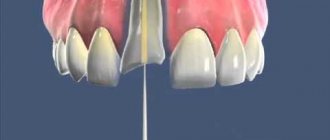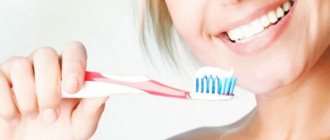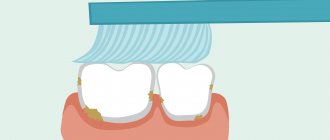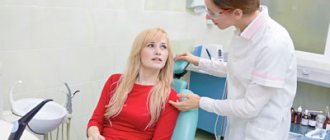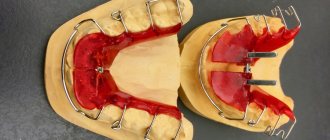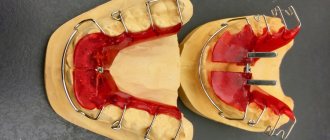Causes of delayed teeth emergence
A lot depends on nutrition: breastfed babies depend on the quality of breast milk. Babies who grow up on artificial formulas receive slightly more vitamins and minerals, because the formulas contain a clearly calculated amount of nutrients.
- If a child does not have a single tooth at 1 year of age, this may be a consequence of some previous disease: intestinal dysfunction, impaired metabolism, as well as insufficient calcium and vitamin D.
- Teeth may be delayed due to the special course of pregnancy; perhaps the mother suffered complications during the gestation period./li>
- Eruption after 12 months may mean that the tooth is not positioned correctly in the gum, for example, it is growing horizontally.
- Congenital absence of tooth buds in a baby. These are either hereditary disorders or a congenital pathology caused by a disruption in the normal course of pregnancy. It happens very rarely.
How can parents understand that at 12 months the baby’s teeth are simply delayed and they need to be patient, and when should they sound the alarm?
Pediatric dentists allow the first teeth to be delayed for 6 months, so if after the baby’s 1st birthday not a single baby tooth has grown, you should wait a little longer. Try to find out from your relatives about the timing and characteristics of the appearance of the first milk teeth in their childhood, perhaps this is just a family trait.
But if the teeth are already delayed by more than 6 months, and the baby’s gums do not even think of swelling, then you should contact a pediatric dentist. The specialist will conduct an examination and advise what needs to be done to help teeth appear faster.
In addition to the above reasons, the appearance of teeth after 12 months may be affected by the following:
- The teeth are located very tightly in the gums.
- There are diseases of the endocrine system, for example, hypothyroidism, due to which the activity of the endocrine glands is reduced.
- The baby suffered serious systemic diseases.
In this case, the pediatric dentist will recommend a biochemical blood test; the baby will need to have the thyroid gland examined, including an ultrasound examination. After the results are obtained, the dentist will be able to prescribe the necessary course of treatment.
Make an appointment
The main reasons for missing teeth
There are various physiological and pathological mechanisms that prevent the timely appearance of teeth. The main reasons for this situation are discussed below.
- Deviation in physical development. This is the most favorable option - teeth will appear soon, only the process is slightly delayed. This is a fairly common case in premature babies.
- Lack of calcium and vitamins in the baby’s body. Improperly introduced complementary foods or the use of non-adaptive mixtures leads to a deficiency of microelements. All organs and systems of the child’s body, including teeth, suffer from this. When normal nutrition is restored, teething will occur, but with a delay, sometimes significant.
- Edentia. This is a hereditary pathological condition characterized by the absence of tooth germs. In this case, chewing function can be restored artificially using implants.
- Mechanical damage to the gums. Sometimes parents make a serious mistake when trying to speed up teething on their own. They deliberately injure the gums, which leads to scars. This not only does not help, but on the contrary, it sharply slows down the process of teeth appearing.
A dentist will help determine the specific cause. Therefore, if there is a delay in the eruption of the first teeth, you cannot postpone a visit to the doctor.
How to help your baby?
Initially, the dentist will take an X-ray of the baby's jaw to make sure that the baby has the rudiments of teeth inside. If there is, then eruption will happen soon. At first, the gums will swell a little and salivation will become very abundant: these are the main symptoms of the rapid appearance of teeth. You can help them a little:
- Teether toys are an excellent device for training gums; they help relieve severe itching and reduce pain.
- Mothers should learn how to gently massage their baby’s gums. It is better to massage with a clean finger lubricated with a special gel for children's gums.
- It is important to add healthy purees and healthy foods to your baby’s diet that will help the child’s body receive the necessary microelements and vitamins.
If the baby generally develops within normal limits, eats well, sleeps, is active and cheerful, then the absence of teeth at 1 year is definitely not a reason to panic. Each child develops at his own pace. In general, boys tend to lag slightly behind girls in some physiological parameters.
From this article it follows that you should not worry unnecessarily! If in any doubt, seek advice from a pediatric dentist at our Babydent
Show more tips
How can you help your baby?
The main question, what to do if a child has no teeth at 8 months, requires an immediate solution. Therefore, the recommendations in such a situation are clear:
- never cause mechanical damage to the gums yourself;
- Chewing can be stimulated using a special device;
- review the baby’s nutritional issues by discussing them with the pediatrician;
- up to 11-12 months you can monitor the situation - nothing bad happens in the child’s body;
- If there are still no teeth, then you need to see a dentist.
What can a doctor do? Despite the child’s infancy, the doctor will prescribe an x-ray of the jaws. This will help diagnose edentia. In any case, you should always strictly follow the recommendations of the pediatric dentist, who will always try to help the baby.
Teething disorders - symptoms and treatment
In case of teething problems, symptomatic treatment is carried out. Its purpose is to eliminate pericoronitis, oral abscess and osteomyelitis.
Treatment of pericoronitis
Treatment of pericoronitis is carried out on an outpatient basis. If the tooth germ is positioned correctly and there is enough space for the dental arch, then surgical treatment is the most preferable option. The mucous membrane in the area of the tooth crown is completely excised. As a result, access to the chewing and lateral surfaces of the crown appears. The operation is performed under anesthesia and can be performed either with scissors or a scalpel, or with more modern methods: cryodestruction, laser and electric knife.
pericoronarotomy can be performed - an operation during which the mucous membrane above the tooth crown is dissected. As a result, tooth surfaces that were previously covered by a hood of mucous membrane are exposed.
After surgical treatment, drug therapy :
- Antibacterial agents are selected individually, taking into account the microflora. It can be:
- Inhibitor-protected penicillins that destroy anaerobic and aerobic microorganisms. Amoxicillin with clavulanic acid is most effective.
- Lincomycin and Clindamycin act against Staphylococcus aureus.
- Metronidazole is not effective against facultative anaerobes and aerobes, but together with other antibiotics it will help cope with mixed microflora.
- Cephalosporins act only together with Metronidazole and Clindamycin, since almost all anaerobic microorganisms are insensitive to them.
- The latest generations of fluoroquinolones are effective against gram-positive bacteria, but each drug has its own level of activity.
- Non-steroidal anti-inflammatory drugs.
- Antihistamines [10].
- Detoxification therapy consists of drinking plenty of warm drinks rich in vitamins, such as compotes and fruit drinks. Sometimes in difficult situations, an isotonic solution is administered intravenously.
To alleviate local symptoms and reduce inflammation, baths with antiseptic solutions are used: a pale pink solution of potassium permanganate, 0.01% Miramistin solution or 0.05% Chlorhexidine.
Treatment of oral abscess
Treatment for an oral abscess includes surgery and medication. Depending on the location of the abscess and the general condition of the patient, it can be performed in a clinic or in a hospital. During the operation, the purulent-inflammatory focus is opened, the postoperative wound is treated with antiseptics and drained.
After surgery, medications must be prescribed. They are similar to those used to treat pericoronitis. To detoxify, it is recommended to drink plenty of alkaline liquids, such as mineral water and cranberry juice.
For several days after the operation, the wound is bandaged daily and treated with antiseptics.
Treatment of osteomyelitis
If osteomyelitis is detected, the patient is immediately hospitalized. The erupting tooth is removed, and all purulent foci are carefully treated. Antibacterial drugs are administered intravenously. For detoxification, saline solutions are used, which are also administered intravenously.
Completely edentulous
This is a rare phenomenon - the complete absence of tooth buds (deciduous or permanent). In this case, teeth cannot erupt because they are simply not in the jaw bone.
Complete edentia in the picture
In medicine, cases have been described when a patient had milk teeth, but permanent teeth were completely absent. The loss of baby teeth was timely, but permanent teeth did not appear in return. At this moment, the child’s parents paid attention to the problem, and the dentist made a diagnosis.
In addition to congenital, adentia can be acquired if the child has undergone severe treatment (chemotherapy) at an early age. Due to the toxic effects of drugs, tooth buds may be damaged.
What to do?
Edentia is clearly visible on a CT image. If such a diagnosis is made, the only option is complete prosthetics. Since the case is rare, the question of when to get dentures and in what way should be decided individually.
If you do not replace missing teeth with prosthetics, the chewing process cannot be complete. Even the lack of 2-3 teeth affects digestion. Bone tissue, if the jaws do not receive enough load when chewing, undergoes resorption (resorption), and this leads to weakening and loosening of the remaining teeth, increasing the risk of periodontal disease.
Therefore, if you have any complaints about your child’s teething being too slow, you should consult a doctor. In most cases, it turns out that there is no pathology, all teeth are fine and will grow a little later. But in rare cases, prosthetics may be required, which is better to know in advance. Then you can schedule treatment on time.
Other articles:
If a child does not want to be treated by an orthodontist...
When should your child see an orthodontist?
How to help your child not be afraid of dentists
Treatment
At an early age, treatment is aimed at actively stimulating proper growth and formation of teeth, as well as diagnosing and preventing their deformation.
Once the main 7 permanent teeth have erupted, you can begin to think about replacing missing ones. In most cases, such treatment is preceded by special preparation carried out by the orthodontist, and then subsequent procedures to restore the missing tooth.
Treatment methods:
- Dental prosthetics using metal-plastic or zirconium oxide-based crowns;
- Adhesive bridge;
- Dental implantation;
For example, with symmetrical defects (no fangs), the doctor may suggest moving the nearest teeth in place of the missing ones to replace them. It is possible to transform nearby teeth (premolars) into fangs by applying a special photopolymer-based material to them. But, in the field of dental treatment, this is aerobatics, which is not accessible to everyone. And now we are not talking about the financial situation, you also need to find an experienced doctor, namely a restorative orthodontist.
Removable prosthetics and implants will help in the fight against edentia
In case of complete secondary adentia (when teeth are completely missing), treatment methods can only be removable prosthetics or, in some cases, installation of implants. Partial secondary adentia can be treated by so-called “ orthodontic preparation ”, in simple terms - prosthetics.
What are normal teething symptoms?
It should be understood that teething is an ordinary physiological process that in itself does not cause serious health problems. However, children during this period may experience anxiety, be capricious, and exhibit a number of alarming symptoms. First of all, in the place where the tooth erupts, swelling and increased sensitivity of the gums are observed. The child begins to actively suck, chew and bite surrounding objects. He has increased salivation, which can irritate the skin around his mouth. These are the main symptoms that are observed in almost all babies. Fever, hyperexcitability, loss of appetite and sleep disturbances are common, but they do not appear with every new tooth. Suffice it to remember that the complete dentition is usually formed by the age of three, and children usually experience severe anxiety only in the first year of life.
For reasons unrelated to teething, the following symptoms may appear:
- increased body temperature;
- frequent bowel movements;
- nausea, vomiting;
- nasal congestion.
First of all, it is necessary to take into account the individual characteristics of the child. The symptoms inherent in a particular constitution can be summarized in a table [3].
| Allergic type (normal excitability of the central nervous system, tendency to allergic manifestations) | Lymphatic-hypoplastic type (reduced excitability of the central nervous system) | Neuro-arthritic type (increased excitability of the central nervous system) |
| Teeth are cut on time and in the correct order. Possible rash, respiratory infections, loss of appetite, and frequent bowel movements. Body temperature is normal. | Teeth cut late and in the wrong order. There is profuse drooling, runny nose, swelling and soreness of the gums, and frequent bowel movements. Body temperature is normal. | Teeth are cut on time and in the correct order. Teething causes pain, excitability, sleep and appetite disturbances, and vomiting is possible. Body temperature rises. |
Vomiting and high fever during teething, caused by the constitution, are characteristic only of the neuro-arthritic type. Only 13.1% of children fall into this category. The main types are lymphatic-plastic, its share is 53.5%, and allergic - 33.4% [3]. Thus, if a child belonging to these two types begins to vomit during teething, it is most likely due to an associated respiratory infection. However, children of the neuro-arthritic type are not protected from infection. The period of teething coincides with the introduction of complementary foods, the baby receives fewer antibodies from mother's milk, and immunity decreases. Therefore, in any case, if the body temperature rises above 38°, vomiting, or thick greenish discharge from the nose, you should call a doctor so as not to miss the onset of pneumonia, pyelonephritis or meningitis.
Teething syndrome is included in the International Classification of Diseases, but is a diagnosis of exclusion. Its signs:
- liquid transparent nasal discharge caused by excess mucus production against the background of gum inflammation (no more than 5 days);
- loose stools up to 5 times a day as a result of salivation, which increases intestinal motility;
- short-term increase in temperature, no more than 38°;
- vomiting, if infection is excluded and the child belongs to the neuro-arthritic type.
Individual characteristics
The average time for the appearance of the first baby tooth is 6 months, but teeth can begin to erupt at three months or a year, and both options are normal. If the child’s teeth do not appear, but there are no other complaints and the pediatrician does not notice any problems, then there is no need to worry until the child is a year or more old.
The same applies to the late beginning of the change of milk teeth to permanent ones. For some children, permanent incisors begin to appear already in the senior group of kindergarten, while others experience this moment at school. The normal period for the formation of a permanent bite is from 7 to 13 years.
Later than the average period, teeth may erupt in weakened, often ill children.
What to do?
Monitor other complaints, contact doctors if necessary, and if there are no complaints, then nothing. You cannot influence the rate at which teeth appear.





